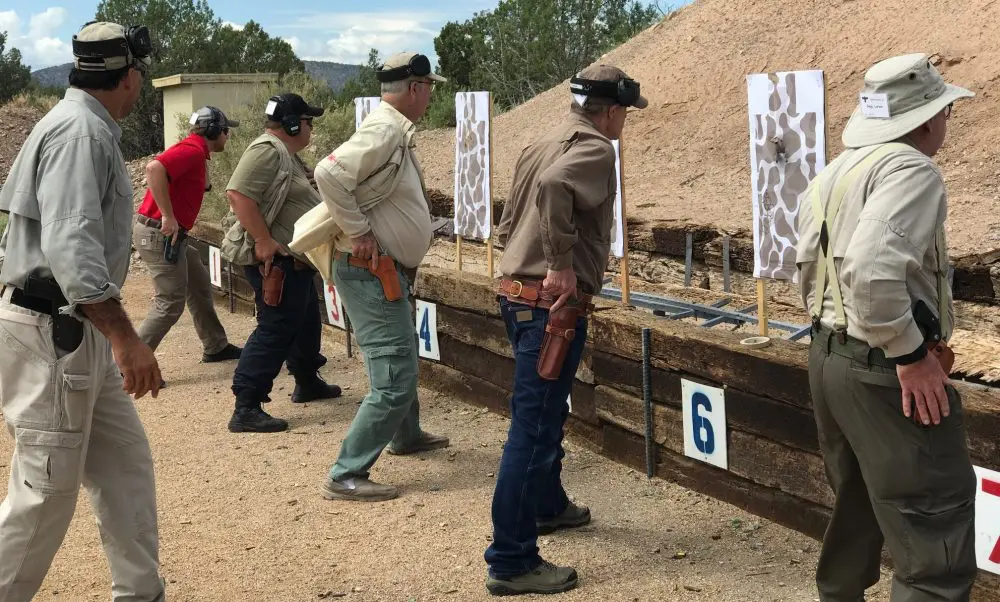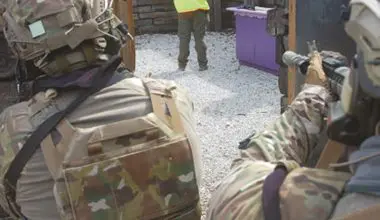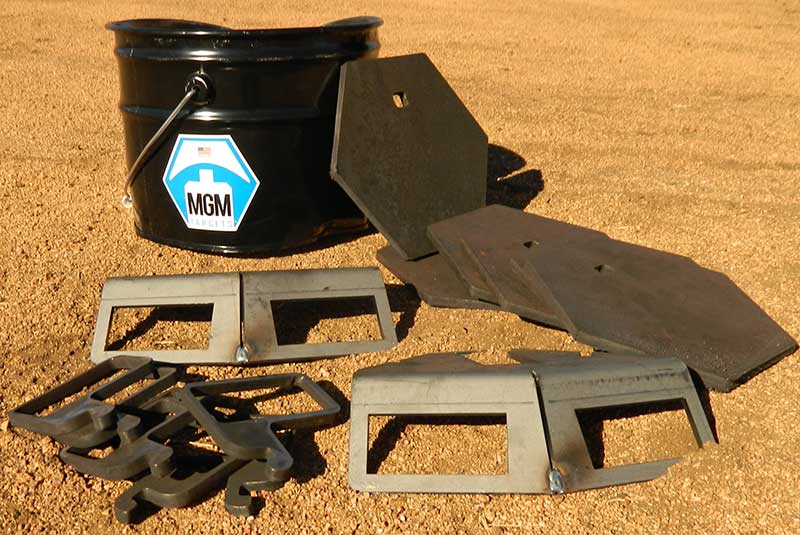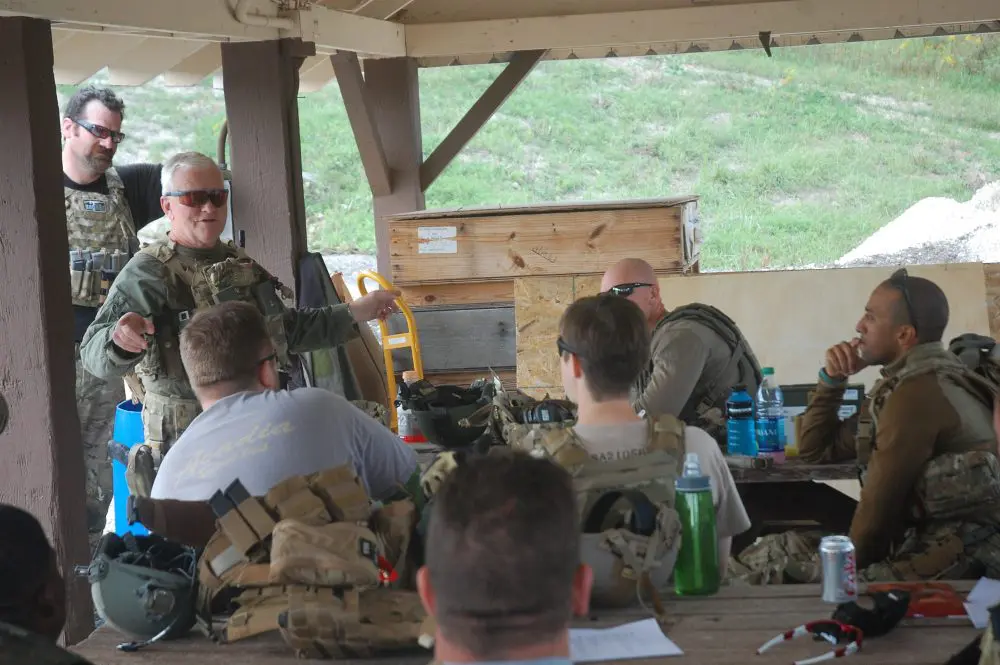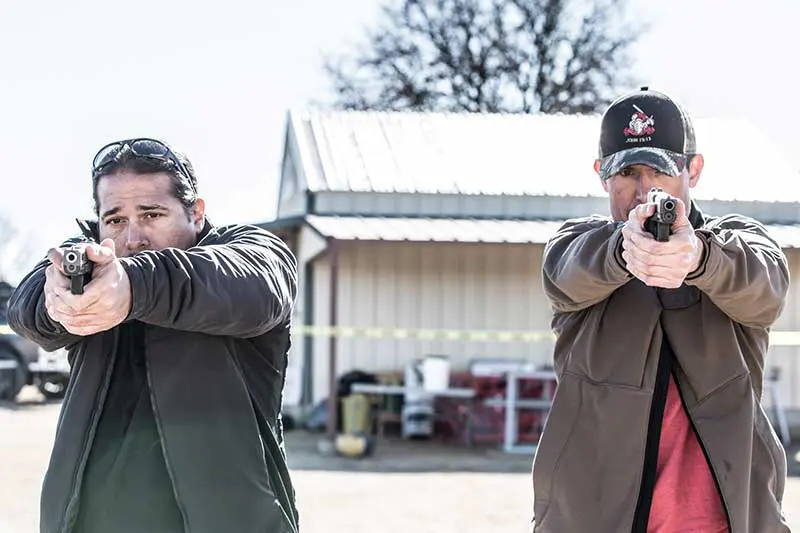When I was a recruit in the Trooper academy, the corporals stressed having a folding knife to cut seat belts. I carried a nice Puma folder in a pouch on my duty belt, and finally had to cut a seat belt in my 16th year with the department—it’s the only time I used it.
The knife was never considered a weapon or addressed in training or policy. The last few years have seen a shift in this outlook toward the duty knife.
In January 2009, a deputy sheriff in Sacramento, California, used his duty knife to stab an opponent who was trying a gun grab. If I have the story right, he made one thrust to the throat, knife in his weak hand, while retaining the gun with his strong hand. The goblin fell to the street with no fight left in him. He later recovered and was charged with assault. The use of the knife was ruled justifiable. I’d like to buy that deputy a glass of amber-colored fluid.

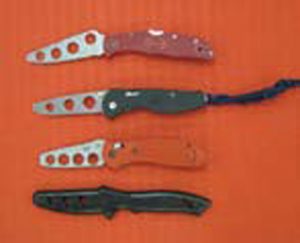
Table of Contents
DEFENSIVE DUTY KNIFE INSTRUCTOR CLASS
I recently participated in a Defensive Duty Knife Instructor class sponsored by the Spokane County, Washington, Sheriff’s Department (SCSD). I do a lot of firearms training for the SCSD, so was glad to be able to join in for this class. The students were all police instructors from Washington, Idaho and Alaska. If they passed the class, they’d be certified to teach their departments.
The lead instructor was Doug Tangen. Doug is the chief firearms and defensive tactics (DT) instructor for the State of Idaho and also operates Centerline Tactics. Doug retired after a 27-year career with a police department and a sheriff’s department.
He was one of the first Master Instructors in defensive tactics in Washington State and holds black belts in Tae Kwon Do, Arnis, and Hojutsu. He’s in his 50s, but can kick, cut, or shoot you better and faster than most guys half his age. Doug was assisted by Officer Rob Boothe of Spokane PD, and Deputy Rob Satake of the SCSD, both of whom are similarly qualified.
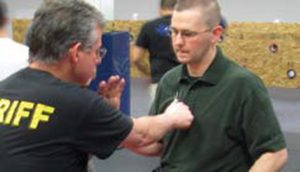
WHAT IT’S NOT
“This is not a knife fighting class!” Doug explained that knife fighting is bladeon- blade which is, well, stupid. He emphasized that the duty knife is the weapon of desperation, not the weapon of choice. If you see a knife or think there is a knife, have a shotgun, carbine or handgun in your hand before the fight starts.

“This is not a martial arts class!” Police administrators are terrified of martial arts training, even though 99% of all police defensive tactics training has roots in one or more traditional arts. The angle kick to the thigh is straight Muay Thai, and any wrist drag is small-circle Jujitsu, but as long as you call it something else, it’s OK. Doug did explain, though, that much of the class is based on Arnis principles. He tries to avoid too much specific technique—he trains the principles and allows lots of leeway in technique.
For example, Officer Boothe demonstrated several Jujitsu and Aikido techniques and then explained how long it takes to learn and master them. He then demonstrated a simple, violent alternative and told the students to go with what they know. It seems like a good approach, and is very similar to a Krav Maga class I recently took in Italy.
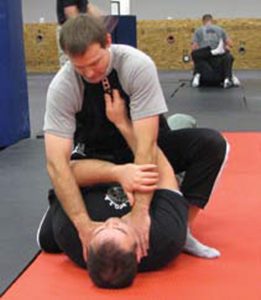
TRAINING DAY ONE
The class began with a half day in the classroom, with the usual introductions and waivers, then moved into the theory of use of the knife and knife defense. A Powerpoint presentation with embedded videos discussed knife users, types of attacks, and defense against a sudden attack. Locations to carry knives, types of knives, and carrying more than one knife were covered.
Doug supports carrying at least two (Rob Satake carries several)—one on the strong side, one on the weak side. It’s important to carry them off the belt line, since a knife on that line can’t be reached if a goblin is in a mount position on top of you.
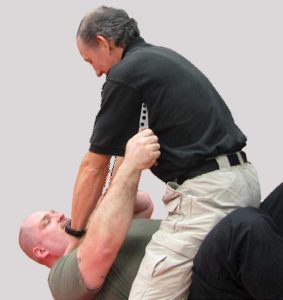
America is gun country, and juries might not understand an officer using a knife. If it doesn’t look like a primary weapon, it might go down better, so the type of knife should be seriously considered.
If you’re carrying a SOG Flash Two, you got lucky with your pocketknife. If you’re carrying an automatic (“switchblade”), a Randall #1, or a Karambit, you’re looking for a knife fight. Doug emphasized being low profile and practical, so the knife doesn’t get tossed from the force options allowed. It’s solid advice—we’ve all worked for knee-jerk weenies who kill a good idea because it looks bad.
KNIVES IN HAND
In the gym, warm-ups were first. There was a lot of emphasis on safety and maintaining a sterile training area. No live weapons of any kind were allowed, with pat-downs whenever anyone entered the training area. We all know how many cops get injured in DT training, since no one is as flexible as they should be.
From the first, the class emphasized dynamic movement off the line of attack, either aggressing into, laterally or away from the opponent. Triangle foot drills, replacement steps and passblock- strike were all incorporated. The instructors then moved into knife defense.
Common knife attacks were described and demonstrated. There may be a world of difference between an attack by Danny Inosanto and a newly released felon, but they can both kill you in a heartbeat. Most Americans dismiss knife attacks with the adage, “I’ve got a gun.” That gun won’t help you in a sudden, violent surprise attack at badbreath distance, so you need some basic understanding of how not to get cut.
Doug quoted Tony Blauer, founder of the excellent SPEAR system: “Contact, control, counter.” This approach to defense against the knife supports the principle of making contact with the knife hand, establishing control, and countering with what you know best. Speed and violence are the watchwords.
The first day ended with knife grips and strike angles. Target areas were attacked from standing positions with the knife in both strong and weak hands. Grip changes from ice pick to fencing style were practiced repeatedly.

TRAINING DAY TWO
Day Two started with a discussion and debrief of Day One, then moved to the gym, where everyone was searched and the safety rules were repeated. After warm-ups, the class reviewed all the material from Day One and moved into ground fighting.
Every force continuum I’ve looked at has ground fighting as a reason for the escalation of force. If I’m on my back with a 225-pound MMA guy on my chest, I can’t stay there long. After target areas were discussed, the teams started working on deploying and using the knife with their partner in a mount position. The teams rotated, so everyone had plenty of opportunity to try to fight from that position. Fighting on your knees, simulating that you’ve slipped or been knocked down, was also given a good amount of time.
TARGET AREAS
There’s nothing pretty about defending yourself with a knife. I talked with Dr. James S. “Doc” Williams about places to stick someone. Doc’s sage advice was to sever muscles or tendons, or cause extreme pain or shock. It can take 40 to 60 seconds to bleed out from a severed artery, so that won’t work. Sever the bicep, tricep, or quadricep, or stab a nerve plexus.
One target that makes me cringe is stabbing upward into the anus and ripping forward—yep, my knees went together too. Doc explained that this is where the greatest concentration of nerves in the body is, and the pain is incredible. I’ll take his word for it. The class covered all these target areas.
FINAL ACTIONS
The last exercise before getting off the mat was a review of all the drills done in the previous two days. It allowed students to bring together the principles and techniques they’d learned—standing, kneeling, supine, right or left handed, icepick or fencer grip.
A lot of time was spent doing a blockpush- shoot exercise, where the attack is deflected and the opponent pushed away and then shot with an Airsoft gun. This drill was emphasized as Plan A, and it was emphasized that we shoot, not talk, when we deflected the attack. I liked that a lot, since the guy has tried to cut me, is still armed and five to ten feet away. To quote Tuco Ramírez, “When you have to shoot, shoot—don’t talk.”
The class wrapped up with a debrief and graduation. Each student was given a workbook and offered a DVD with the entire Powerpoint, manual, etc. for $20, which seemed very reasonable. Each student got a sample knife policy for inclusion in the department SOP. SOG Knives, in support of law enforcement, provided discount cards to each student.
All told, it was two days well spent. This is a class whose time has come— deadly force is deadly force. Like the firearm or baton, an officer needs documented quality training before he has to use deadly force with any weapon. This well-constructed and presented class, by very qualified instructors, meets that need.
While this class was held in the Great Northwest, in the future it would be a good thing to see departments all the way to the Florida Keys offering this kind of training. They owe it to their officers.
